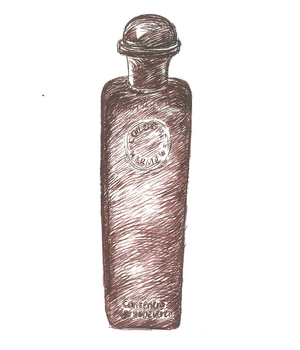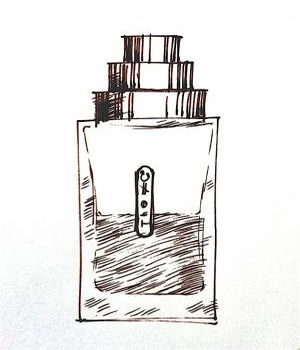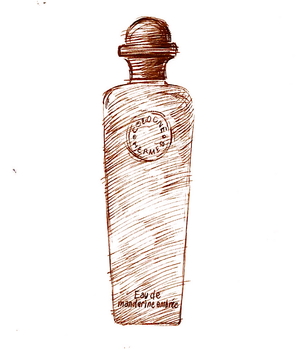Tagged With ‘“Jean-Claude Ellena”’
Hermès
Concentré d’Orange Verte
18 July, 2014
 In 1979, Hermès launched a brilliant take on the classic men’s eau-de-cologne. Simply called Eau de Cologne d’Hermès, it was created by Françoise Caron, who you could almost say had perfume in her blood. Born in the one-time capital of French fragrance, the Provençal town of Grasse, into a family that worked in the perfume trade, both she and her brother, Olivier Cresp, became highly regarded professional perfumers in their own right.
In 1979, Hermès launched a brilliant take on the classic men’s eau-de-cologne. Simply called Eau de Cologne d’Hermès, it was created by Françoise Caron, who you could almost say had perfume in her blood. Born in the one-time capital of French fragrance, the Provençal town of Grasse, into a family that worked in the perfume trade, both she and her brother, Olivier Cresp, became highly regarded professional perfumers in their own right.
Many perfumes are variations on a theme, and the fresh, citrusy scent of eau-de-cologne is probably the best-known theme of all. But some variations are more interesting and successful than others, and Françoise Caron’s master-stroke was to turn up the volume, if you like, on a single ingredient – bitter orange – that plays a subsidiary role in most colognes.
The effect is delicious and bracingly sour-sweet, like a proper old-fashioned lemonade, but because orange is a more powerful, complex citrus scent than lemon it has far more depth and staying power. Françoise Caron also included mint (which adds a minor cooling touch), as well as lime and blackcurrant buds – which, if like me you have blackcurrant bushes in your garden, you’ll know have an intriguing scent, both sweet and slightly foxy.
Eau de Cologne d’Hermès continued in production until 1997, when Hermès changed its name to the slightly more individual Eau d’Orange Verte, though the scent remained the same. One criticism of Caron’s original perfume was that it didn’t last very long, and presumably as a response to this, in 2004 a concentrated version was released, tweaked by in-house perfumer Jean-Claude Ellena and helpfully called Concentré d’Orange Verte.
It’s this version I like best, I suppose because it seems to have retained all the character of Françoise Caron’s original yet packs a rather more powerful punch, and on my skin at least it certainly seems to last a good hour or two. It’s a zesty, uplifting and – I’d say – a happy scent, and one that I’d happily wear every day. Perfect for lifting the spirits on a dull grey Monday morning.
Different Company
Osmanthus
8 July, 2014
 Much excitement in Weymouth, as the old Woolworth’s site has been transformed into a branch of T.K.Maxx. Even more excitement when, on our first visit, what should I pluck from the trashy mass-market scents you’d expect to find in a discount outlet but a brand-new bottle of Osmanthus by The Different Company.
Much excitement in Weymouth, as the old Woolworth’s site has been transformed into a branch of T.K.Maxx. Even more excitement when, on our first visit, what should I pluck from the trashy mass-market scents you’d expect to find in a discount outlet but a brand-new bottle of Osmanthus by The Different Company.
What a highly collectible perfume by a fairly obscure, high-end brand was doing in the Weymouth branch of T.K.Maxx I have no idea, but there it was, ours for the princely sum of £16.99 (recommended retail price €142).
Created by the much-admired perfumer Jean-Claude Ellena (now the in-house perfumer for Hermès) for the company he founded in 2000, Osmanthus gets an admiring review in the even more widely admired Perfumes: The Guide by Luca Turin and Tania Sanchez, and you can see why.
It’s a gentle, sweet but subtle scent, whose plush peachy centre is reminiscent of Guerlain’s timeless Mitsouko, though it seems to lack either Mitsouko’s strength of character or its mysterious staying-power. Yet Osmanthus has magic of its own, and its apparent evanescence on the skin proves something of a disappearing trick – for after putting a little on the back of my hand and noting that it didn’t seem to last very long, what should happen but that an hour or two later, as if from nowhere, its fresh, fruity scent would suddenly snap into focus again, almost as strong as when I first sprayed it on.
I’ve no idea how it’s done, or even whether the effect was intentional, but my guess is that it’s got something to do with the way Osmanthus’ peachiness bonds with the perfume’s other elements, some of which are a little surprising, like castoreum, a resinous compound extracted from beavers that has a leathery, animalic smell and is also found in Chanel’s wonderful Cuir de Russie.
Natural osmanthus, incidentally, is an attractive evergreen shrub which, in sheltered conditions, will grow to the size of a small tree. It grows wild in the Himalayas, China and Japan and was first introduced to European gardens in 1771, where it became known as Sweet Tea or Fragrant Olive. In the autumn it bears thousands of small but intensely fragrant white flowers, whose intoxicatingly sweet scent gives the plant its botanical name, Osmanthus fragrans.
Its fragrance, indeed, is remarkably powerful, as we discovered on an autumn visit to the enchanted garden of Brécy, near Bayeux. From the massively stepped levels of the formal gardens, which form a kind of vast single staircase up towards the Normandy sky, we recognised osmanthus’ heady scent a long time before we finally located its source, from a couple of dark columnar trees planted close against the south wall of the church, outside the gardens themselves.
Despite the sheer intensity of its fragrance, this is one of the only powerfully sweet scents I know that one can never smell enough (unlike, say, Madonna lilies, whose scent becomes overwhelming after a while): there’s a fresh lemony edge to osmanthus that makes it refreshing and intoxicating all at once. Enjoy Jean-Claude Ellena’s perfume by all means, but plant the tree wherever you can.
Hermès
Eau de Mandarine Ambrée
1 June, 2014
 Now this is fun. Eau de Mandarine Ambrée isn’t perhaps the most sophisticated perfume in the world, but it’s a jolly, cheering little scent, that smells sweet and zesty and pretty much exactly like mandarin juice when you first spray it on. It was launched in 2013, at the same time as Eau de Narcisse Bleu, and brings the number of Hermès colognes up to five (the other three being Eau d’Orange Verte, Eau de Gentiane Blanche and Eau de Pamplemousse Rose).
Now this is fun. Eau de Mandarine Ambrée isn’t perhaps the most sophisticated perfume in the world, but it’s a jolly, cheering little scent, that smells sweet and zesty and pretty much exactly like mandarin juice when you first spray it on. It was launched in 2013, at the same time as Eau de Narcisse Bleu, and brings the number of Hermès colognes up to five (the other three being Eau d’Orange Verte, Eau de Gentiane Blanche and Eau de Pamplemousse Rose).
Like all the more recent Hermès perfumes it was created by Jean-Claude Ellena, whose celebrity status says much about how the industry has changed over the last decade or so – in the past no one would have known his name. His perfumes are nearly always interesting, if not always terrifically commercial, and Hermès seem to have given him licence (if you’ll forgive the pun) to follow his own nose and see where it takes him, especially with the colognes and it Hermessences range – see my review of Vétiver Tonka.
Ellena is very interested in food, and like quite a few of his perfumes, Eau de Mandarine Ambrée reminds me of cooking smells: nice cooking smells, that is. In this case it reminds me of the ugli-fruit marmalade that Roy made this year, which is very nice in its own way, but lacks the tartness of Seville-orange marmalade, and tastes a bit too sweet and jammy as a result.
Still, you could do far worse than start your day with Eau de Mandarine Ambrée. It’s light and refreshing and puts a smile on your face, yet it’s longer-lasting than most citrus-based colognes. This seems to be because Ellena has combined mandarin with a bit of passion-fruit extract and what’s known in the perfume trade as amber (thus Mandarine Ambrée).
‘Amber’ is one of those confusing terms that gives perfumery a bad name: it’s nothing to do with amber, the fossilised resin, or ambergris, the strange waxy lumps that whales occasionally cough up after swallowing too many cuttlefish (I kid you not), which develop a wonderful aroma only after bobbing around in the sea for a few years.
For perfumers, ‘amber’ refers to a careful blend of several ingredients, usually vanilla, benzoin and labdanum, which together give a sweet, slightly resinous and powdery smell. Ellena himself says that ‘I can think of no smell more joyful than mandarin, more mellow than amber,’ and I guess it’s the amber that helps Eau de Mandarine Ambrée last as long as it does.
Would I wear it a lot? Personally I prefer the sharper smells of colognes like Monsieur Balmain and Eau d’Orange Verte, but for anyone who likes something a bit sweeter and softer then Eau de Mandarine Ambrée would be a very happy choice.